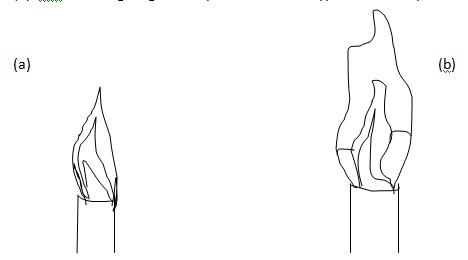Question
.(i) What is a flame?
(ii). The following diagrams represent the two types of flames produced by a bunsen burner.

(a). Identify the flames (a) and (b).
(b). Which type of the flames identified above is preferred for heating? Give a reason for your answer.
(c). give four differences between the flames (a) and (b) above.
(d)(i). Give two reasons why flames (a) and (b) in 4(ii) above differ.
(ii).A wooden splint was slipped through a region of a particular flame of the Bunsen burner in the laboratory. The splint was burnt as shown in the diagram below.

(a). Name the type of flame the splint was slipped through.
(b).Explain why the splint was burnt the way it is shown in the diagram.
(iii). After use, the non-luminous flame should be put off or adjusted to luminous flame. Explain.
(iv). Putting off flames is one of the laboratory safety rules. State four other rules.
(ii). The following diagrams represent the two types of flames produced by a bunsen burner.

(a). Identify the flames (a) and (b).
(b). Which type of the flames identified above is preferred for heating? Give a reason for your answer.
(c). give four differences between the flames (a) and (b) above.
(d)(i). Give two reasons why flames (a) and (b) in 4(ii) above differ.
(ii).A wooden splint was slipped through a region of a particular flame of the Bunsen burner in the laboratory. The splint was burnt as shown in the diagram below.

(a). Name the type of flame the splint was slipped through.
(b).Explain why the splint was burnt the way it is shown in the diagram.
(iii). After use, the non-luminous flame should be put off or adjusted to luminous flame. Explain.
(iv). Putting off flames is one of the laboratory safety rules. State four other rules.
Answer
(i). Aflame is a mass of burning gases.
(ii)(a) a- non-luminous flame
b-luminous flame.
(b). a- non-luminous flame. Produces much heat.
(c).TABLE EMPTY
(d)(i). a-non-luminous flame is produced when the air hole is open while the luminous flame (b) is produced when the air hole is closed.
(ii)(a).non luminous flame.
(b). the inner part has unburnt gases hence not hot while the outer part has completely burnt gases and is therefore hotter.
(iii)- to preserve the gases, to avoid fire accidents because non-luminous flame is not easy to sea .
(iv).chemicals already used should be disposed off immediately to avoid contamination, if a chemical gets into your skin or mouth, rinse it immediately with a lot of clean water,always extinguish flames that are not in use to avoid accidents and to minimize fuel wastage, never taste or eat anything in the laboratory to avoid poisoning, label all the chemicals you are using to avoid confusion.(accept any correct)
(ii)(a) a- non-luminous flame
b-luminous flame.
(b). a- non-luminous flame. Produces much heat.
(c).TABLE EMPTY
(d)(i). a-non-luminous flame is produced when the air hole is open while the luminous flame (b) is produced when the air hole is closed.
(ii)(a).non luminous flame.
(b). the inner part has unburnt gases hence not hot while the outer part has completely burnt gases and is therefore hotter.
(iii)- to preserve the gases, to avoid fire accidents because non-luminous flame is not easy to sea .
(iv).chemicals already used should be disposed off immediately to avoid contamination, if a chemical gets into your skin or mouth, rinse it immediately with a lot of clean water,always extinguish flames that are not in use to avoid accidents and to minimize fuel wastage, never taste or eat anything in the laboratory to avoid poisoning, label all the chemicals you are using to avoid confusion.(accept any correct)

